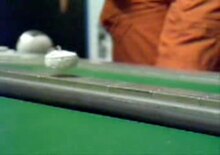Yttrium-barium-copper oxide
| Crystal structure | |||||||||||||
|---|---|---|---|---|---|---|---|---|---|---|---|---|---|

|
|||||||||||||
| __ Y 3+ __ Ba 2+ __ Cu 2+ __ O 2− | |||||||||||||
| General | |||||||||||||
| Surname | Yttrium-barium-copper oxide | ||||||||||||
| other names |
|
||||||||||||
| Ratio formula | YBa 2 Cu 3 O 7-x | ||||||||||||
| External identifiers / databases | |||||||||||||
|
|||||||||||||
| properties | |||||||||||||
| Molar mass | 666 g mol −1 | ||||||||||||
| Physical state |
firmly |
||||||||||||
| safety instructions | |||||||||||||
|
|||||||||||||
| As far as possible and customary, SI units are used. Unless otherwise noted, the data given apply to standard conditions . | |||||||||||||
Yttrium-barium-copper oxide , abbreviated as YBCO or YBaCuO , is a group of superconductors that was discovered in 1987 and consists of the chemical elements yttrium , barium , copper and oxygen . With a transition temperature of 92 K (−181.15 ° C ) they belong to the group of high-temperature superconductors .
The development of high temperature superconductors
High-temperature superconductivity (HTSL) was heralded in 1986 by Johannes Georg Bednorz and Karl Alexander Müller with the discovery of superconductive oxocuprates in the La – Ba – Cu – O system . Investigations on Jahn-Teller distorted metal oxides showed that oxocuprates have significantly higher transition temperatures compared to the previously known superconductors.
This finding sparked a wave of research that reached a preliminary peak with the discovery of YBa 2 Cu 3 O 7 – x (also known as Y123, 123 oxide, YBCO or YBaCuO). YBa 2 Cu 3 O 7 – x was the first compound for which a transition temperature above the boiling point of liquid nitrogen was detected with T c = 92 K. In the years that followed, numerous other oxocuprates of greater structural and chemical complexity were discovered. The astonishing thing about these connections and the high-temperature superconductivity is that on the one hand, according to the BCS theory, a transition temperature of over 40 Kelvin cannot be explained (since at these temperatures the thermal energy of the lattice vibrations would actually prevent the formation of Cooper pairs ) and on the other hand others that the material found is not a metallic conductor , but a ceramic .
Probably the most precisely characterized and intensively investigated oxocuprate is YBa 2 Cu 3 O 7 – x . The structure of YBa 2 Cu 3 O 7 can be considered a defective variant of the perovskite be construed type (AMO3), in which 2 / 9 remain unoccupied, the oxygen positions.
Only the orthorhombic modification with x <0.6 is superconductive .
Manufacturing
Compounds of the type YBa 2 Cu 3 O 7-x may in special furnace processes at up to 900 ° C from either yttrium nitrate , barium nitrate , copper nitrate , oxalic acid and urea or yttrium oxide , barium carbonate , and oxide of copper (II) be prepared.
literature
- F. Schwaigerer, B. Sailer, J. Glaser, HJ Meyer: Electricity served ice cold: superconductivity . In: Chemistry in our time , 2002, 36 , pp. 108–124
- PI Djurovich, RJJ Watts: A simple and reliable chemical preparation of YBa 2 Cu 3 O 7-x superconductors: An experiment in high temperature superconductivity for an advanced undergraduate laboratory . In: Journal of Chemical Education , 1993, 70 , pp. 497-498.
Web links
Individual evidence
- ↑ a b Data sheet Yttrium barium copper oxide from Sigma-Aldrich , accessed on April 25, 2011 ( PDF ).

